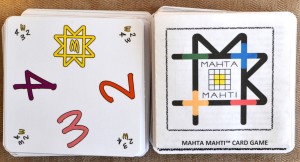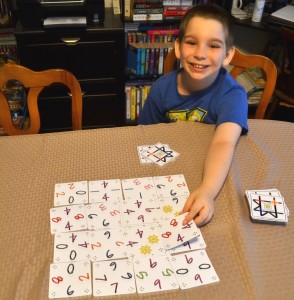Sharpen your pencils and flex your math muscles, it’s time to play “Mahta Mahti”! In this easy-to-play card game designed for three to ten players, you’ll be trying to match numbers on the cards you play in order to score points. The game itself comes with a deck of one-hundred and twenty-nine square playing cards. The four numbers listed on any one card can vary, forcing players to think about which card they should play when considering the playing field as it stands. Before we get into specifics, I’d like to thank Jeff Greenmun from Mahta Mahti Ent, LLC for providing me with a prototype copy. It’s worth noting that because this copy is a prototype, it’s possible that the pictures you’ll see in the content below are not fully representative of the final product.
When I initially looked at the rules for the game, I sighed loudly and anticipated a complex card game that would result in the consumption of pain relievers later that day. I’m glad to report that the game wasn’t nearly as complicated as I thought. The game setup, for example, is very simple. Each player receives twelve cards, six of which will form their hand while the other six forms their own personal draw pile. As players lay down cards, they’ll draw from their personal draw pile (called the reserve deck) so that they always have a hand of six cards. Lastly, four cards are dealt face-up onto the center of the table to form a giant square. This square will be known as the “House Field”…keep this in mind as I’ll be referencing it later.
On a player’s turn, they’ll pick a card from their hand and play it on the table. It’s important to note however that the dealer is limited to playing cards on the “House Field” while everyone else is limited to playing cards on the “Ring Field”. As the name implies, the “Ring Field” is the area surrounding the “House Field”. The largest the entire grid can get, for the record, is 4×4 (or sixteen cards). At the beginning of the game, there will be no cards on the “Ring Field”, so everyone but the dealer will be seeding this area until the ring is filled up. Cards, whether they are played by the dealer or the other players, will be placed on top of an existing card. The dealer will be immediately playing over other cards in the “House Field” on his/her turn, but it may take a few turns before this occurs for the others since they’ll need to first seed the “Ring Field”.
Scoring is where the math comes into play. When a player places a card on the table, they’ll look to see which numbers match on all sides of the card. Numbers that match are added together, then doubled. In the case of matching fives, the player would earn twenty points ((5+5 = 10) X 2). If the player manages to match numbers on more than one side, they’ll earn points accordingly for each side matched. If a player doesn’t match a number, they’ll be penalized by the sum of the two numbers. Numbers that don’t border another card aren’t considered when scoring. Players continue placing cards and earning points until they run out of cards to play. The person with the most points at the end of it all, wins! The manual covers the above concepts in greater detail, but this should give you a general idea on how the game is played.
While this game indicated that a minimum of three players was needed, I didn’t feel there to be any issues in coming up with a two player variant. For example, both players could have the option to play wherever they wanted, regardless of who was dealing. I myself opted to introduce twelve cards to the reserve deck instead of six for a two player game, and it seemed to work out well. I appreciated this flexibility, mainly because it would serve as a great educational tool in a one-on-one setting. By that same token, “Mahta Mahti” would be ideal for any grade school arithmetic class since it incorporates addition, subtraction, and multiplication all in one sitting. I really enjoy covering educational games like “Mahta Mahti”, as they allow younger minds the ability to learn without the entire process feeling like a chore.
To sum this preview up, “Mahta Mahti” is an excellent idea that deserves your attention and support. The game is easy to learn, fun to play, and promotes critical thinking. I enjoyed watching Vinnie (12) crunch those numbers in his head to see which card and which space would earn him the most points. Mahta Mahti (wild) cards can be a bit overpowered, as they allow matches on all sides scoring the player a TON of points…though I don’t see why games couldn’t be played to where they were taken out of the deck prior to playing. While this game may appeal more to parents and families as opposed to the hardcore gamer crowd, it would still serve well as a filler in between longer play sessions. If you haven’t come across this game on Kickstarter yet, then feel free to check it out by following the links below.
—
“Mahta Mahti” is currently being funded through Kickstarter (as of 8/9/13). You can learn more about and support the game by visiting the following websites:
http://www.kickstarter.com/projects/858789401/mahta-mahti-card-game
http://www.boardgamegeek.com/boardgame/146116/mahta-mahti
—



This game is ingenious! I can’t wait for it to come out so I can play it with my kids. Card games are the family favorite, and I can see this game being frequently asked for.